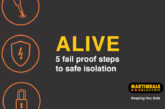
You wouldn’t drink and drive… so why would you work on a circuit without isolating it? Gary Parker, ECA Technical Manager, offers his thoughts.
Every year, individuals working on electrical installations suffer avoidable electric shock and burn injuries. Some of these are, tragically, fatal. According to the Office for National Statistics (ONS) and the Health and Safety Executive (HSE), between 2015 and 2020, 21 people died through contact with electricity, and many more were injured. It is vital that ECA members and the wider electrical contracting industry know that many of these accidents are a direct consequence of installers neglecting proper isolation procedures on low voltage installations (operating at up to 1,000V AC or 1,500V DC).
ECA’s new electrical installer safety campaign – “Don’t cut corners! Plan, test, isolate”– aims to raise awareness of this issue, promote safe isolation procedures, and ultimately reduce the number of injuries caused by incorrect isolation of low-voltage circuits.
Employers: what are your obligations?
A lot of the responsibility lies with employers, and the onus is on them to make sure proper safety procedures are in place. Employers are responsible for ensuring that employees engaged in work with electrical systems have the technical knowledge, training and experience to carry out their work safely and competently, and are provided with suitable tools, test equipment and PPE.
The Health and Safety at Work Act 1974 sets out the general health and safety duties of employers, employees and the self-employed. The Electricity at Work Regulations 1989 are also key. They require precautions to be taken against the risk of death or personal injury from electricity during work activities. To comply with these regulations, work on electrical equipment or circuits should always be undertaken with the system powered down and isolated (known as ‘dead’ working). ‘Live’ working should only be carried out in very special circumstances where it is unreasonable to work dead, such as fault finding and testing, where the risks are acceptable, and where suitable precautions can be taken against injury.
The Provision of Work Equipment Regulations (PUWER) also require that ‘every employer shall take appropriate measures to ensure that re-connection of any energy source to work equipment does not expose any person using the work equipment to any risk to health or safety.’
What is isolation?
Isolation means safely establishing a break in the energy supply to an installation. This also means making sure an inadvertent reconnection is not possible. The key principle of isolation is that the point of isolation should be under the control of the person who is carrying out the work on the isolated equipment – if you are working on an installation, you should know exactly what has been done to isolate it, along with the risks that may be involved, and what to do in an emergency.
Securing the point of isolation should be by a combination of the following methods:
● A padlock with unique key or combination.
● A locked switch-room door or locked distribution box.
● Circuit breakers should be locked-off using an appropriate locking-off clip with a padlock.
● Removal of the relevant circuit fuse (may be used with a lockable fuse insert and padlock).
Any padlock keys or combinations and removed fuses should be retained by the person carrying out the work. Where more than one person is working on an installation, a multi-lock hasp can be used to prevent access to a main isolator until everyone has completed their work and removed their padlocks from the hasp.
In all instances where there is a risk that the supply could be inadvertently reinstated, a clear and visible warning notice should be placed at the point of isolation reading something along the lines of, “Caution Do Not Switch On, System Undergoing Maintenance”.
The campaign
The simple truth is you’re more likely to be seriously injured if you work on electrical systems than you are in almost any other field of work. The following extract, taken from the HSE’s training brochure, supports this point:
“In Great Britain, roughly 2 in every 50 electrical accidents at work result in a fatality, compared with 1 in 500 from other causes. As well as electric shock, other electrically-related injuries arise from burns, arcing and fires. Many of the injuries can take a long while to heal and often result in life-changing conditions.”
At the end of the day, safe isolation could save your life. Don’t cut corners, and don’t leave your employees’ (or your own) safety to chance.
To download Electrical Safety First’s best practice guide click here
To watch a best practice safe isolation video click here










